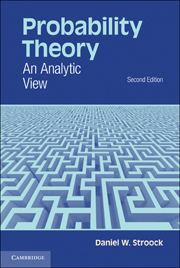Book contents
- Frontmatter
- Contents
- Preface
- Table of Dependence
- Chapter 1 Sums of Independent Random Variables
- Chapter 2 The Central Limit Theorem
- Chapter 3 Infinitely Divisible Laws
- Chapter 4 Lévy Processes
- Chapter 5 Conditioning and Martingales
- Chapter 6 Some Extensions and Applications of Martingale Theory
- Chapter 7 Continuous Parameter Martingales
- Chapter 8 Gaussian Measures on a Banach Space
- Chapter 9 Convergence of Measures on a Polish Space
- Chapter 10 Wiener Measure and Partial Differential Equations
- Chapter 11 Some Classical Potential Theory
- Notation
- Index
Chapter 8 - Gaussian Measures on a Banach Space
Published online by Cambridge University Press: 05 June 2012
- Frontmatter
- Contents
- Preface
- Table of Dependence
- Chapter 1 Sums of Independent Random Variables
- Chapter 2 The Central Limit Theorem
- Chapter 3 Infinitely Divisible Laws
- Chapter 4 Lévy Processes
- Chapter 5 Conditioning and Martingales
- Chapter 6 Some Extensions and Applications of Martingale Theory
- Chapter 7 Continuous Parameter Martingales
- Chapter 8 Gaussian Measures on a Banach Space
- Chapter 9 Convergence of Measures on a Polish Space
- Chapter 10 Wiener Measure and Partial Differential Equations
- Chapter 11 Some Classical Potential Theory
- Notation
- Index
Summary
As I said at the end of § 4.3.2, the distribution of Brownian motion is called Wiener measure because Wiener was the first to construct it. Wiener's own thinking about his measure had little or nothing in common with the Lévy–Khinchine program. Instead, he looked upon his measure as a Gaussian measure on an infinite dimensional space, and most of what he did with his measure is best understood from that perspective. Thus, in this chapter, we will look at Wiener measure from a strictly Gaussian point of view. More generally, we will be dealing here with measures on a real Banach space E that are centered Gaussian in the sense that, for each x* in the dual space E*, x ∈ E ↦ 〈x, x*〉, ∈ ℝ is a centered Gaussian random variable. Not surprisingly, such a measure will be said to be a centered Gaussian measure on E.
Although the ideas that I will use are already implicit in Wiener's work, it was I. Segal and his school, especially L. Gross, who gave them the form presented here.
The Classical Wiener Space
In order to motivate what follows, it is helpful to first understand Wiener measure from the point of view which I will be adopting here.
- Type
- Chapter
- Information
- Probability TheoryAn Analytic View, pp. 299 - 366Publisher: Cambridge University PressPrint publication year: 2010

